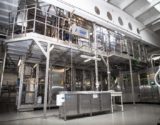NIZO hats today started with a series of online webcasts on topics of high importance to the milk processing industry. Professor Peter de Jong, Principal Scientist Processing for NIZO, presented how processes can be optimised to reduce costs and add value.
Processing technology and in-deep product knowledge are the keys to sustainable dairying and profit, de Jong said. This translates into lowering processing costs and adding value to products. There are many unexplored measures to increase the runtime of production lines by reducing fouling. An optimised CIP process can result in 10 – 20% longer runtime and reduced fouling may lead to 50% longer production runs, de Jong said. Process optimisation refers not only to equipment and process conditions, it must also meet all quality requirements, said deJong pointing out that NIZO operates Europe‘s largest pilot plant and has decades of experience in process optimisation worldwide.
An example was taken from the infant formula industry. A new recipe proved problematic as it reduced runtime to 2 hours. NIZO together with the processor managed to increase runtime to 12 hours by highly reducing fouling. The product benefitted from less cooked-off flavour development.
Optimising cleaning procedures is low hanging fruit, de Jong said. Many such processes are designed in a suboptimal way. A thorough otimisation, however, needs on-site analysis of process conditions and taking of samples, the definition of an optimum CIP process and its validation. Savings of €100,000 a year can be generated just from CIP of a single optimised processing line.
NIZO can also help in data analysis, making use of already existing data in a factory but bringing together process and quality. This can generate a substantial cost reduction. NIZO is currently optimising processes for FrieslandCampina and Vreugdenhil Dairy Foods where the Maillard reaction in infant formula making is at the core. De Jong said that just a few smart process changes may lead to a highly improved final product that is well accepeted by B2B customers.
Another example in the NIZO webcast was taken from cheese making. Manufacturers look for high yield to stay profitable. A cheese plant reported of high variations of moisture in its cheeses. NIZO found out that the temperature in one buffer vessel was responsible for this. In the end, the customer enjoyed an improvement of €1m p.a. in profitability.
Finally, de Jong described NIZO’s direct steam injection process developed for fresh milk. This process makes it possible to heat milk from 60 °C to 160 °C and cool it down again to 60 °C in less than a second. The result is a fresh milk with a shelf-life of 60 days and no sensorial difference to normally pasteurised milk.
The webcast and the following webcasts by NIZO are available via this link:
NIZO Dairy Webcast Series – NIZO



